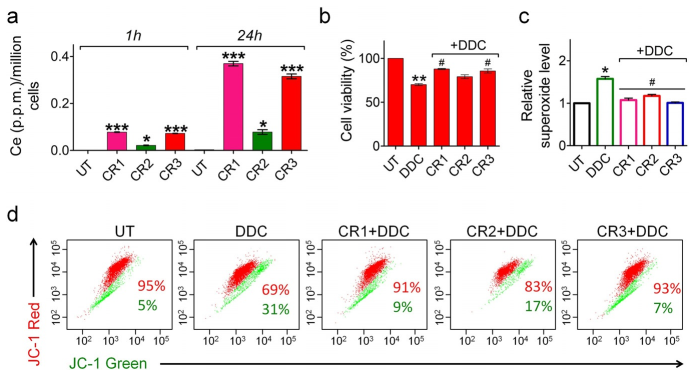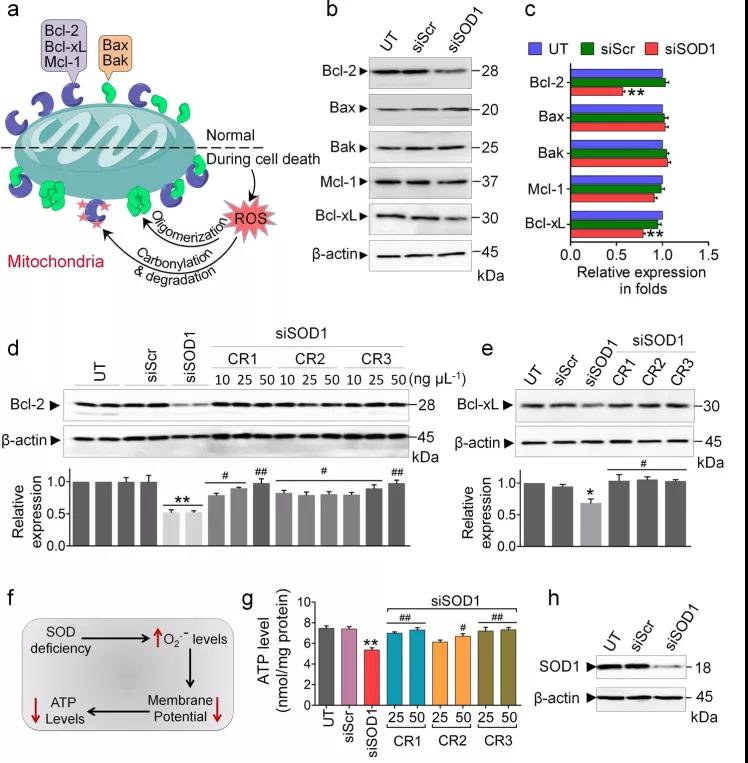
hotline:
17715390137
Tel/Wechat:
18101240246 (Technology)
0512-68565571
Email:mxenes@163.com (Sales Engineer)bkxc.bonnie@gmail.com
Scan the code to follow or search the official account on WeChat:
2D Materials Fronrier After paying attention,
click on the lower right corner to contact us,
Enter enterprise WeChat.
Professional Services Online

Lead
Superoxide is one of the main reactive oxygen species (ROS) produced in mammalian cells. Excessive accumulation of superoxide in cells can cause damage to cell components. Superoxide dismutase (SOD) can regulate the level of superoxide in cells. In mammalian cells, SOD has three subtypes, including cytoplasmic SOD (SOD1), mitochondrial SOD (SOD2) and extracellular SOD (SOD3). Among them, the most abundant SOD1 subtype also exists in the mitochondrial membrane space and regulates Cell superoxide content and maintaining the stability of mitochondrial membrane play an important role. Studies have shown that the imbalance of mitochondrial membrane potential caused by the accumulation of ROS due to the loss of SOD function will affect the mitochondrial energy supply function, and neurons are highly dependent on ATP, so the loss of SOD enzyme activity is related to many neurological diseases such as Alzheimers disease. The development of artificial enzymes with specific SOD activity can maintain the integrity of mitochondria and the redox homeostasis of cells, which is of great significance for the treatment of various neurological diseases.
Nanoenzymes are a class of nanomaterials with enzyme-like activities. Due to their potential in the biomedical field, nanoenzymes have attracted widespread attention. However, most of the nanoenzymes reported at present have oxidase (OXD). Or peroxidase (peroxidase, POD) activity, nanozymes with SOD activity and other regulation of cell redox levels are few, and whether nanozymes can completely replace the key functions of natural enzymes in cells is still unclear. In response to the above problems, the Govindasamy Mugesh team of the Indian Institute of Science and Technology has developed a cerium vanadate (CeVO4) nanozyme with high SOD enzyme activity, which can control the superoxide level of SOD1 and SOD2 deficient neurons, thereby restoring mitochondrial function. Regulate ATP levels. In addition, CeVO4 nanozymes can restore the function of anti-apoptotic Bcl-2 family proteins under oxidative stress conditions and protect neuronal cells.
Experiment content
1. Synthesis and characterization of CeVO4 nanoenzyme:
Using EDTA as a stabilizer, CeVO4 nanorods with sizes of 50 nm (CR1), 100 nm (CR2), and 150 nm (CR3) were synthesized by hydrothermal method. Observation by transmission electron microscope showed that it has good uniformity and dispersion. (Figure 1), the high-resolution TEM image shows regular fringes corresponding to the [200] plane of the square CeVO4 nanorods.

Figure 1 TEM and HRTEM images of CeVO4 nanorods of different sizes: a, b) 50 nm (CR1), c, d) 100 nm (CR2), e, f) 150 nm (CR3).
2. Detection of SOD enzyme activity of CeVO4 nano-enzyme:
The SOD enzyme activity of CeVO4 nanozymes was measured using WST-1 kit. CeVO4 of three sizes has SOD enzyme activity (Figure 2). Compared with the SOD nanozymes that have been reported so far, the CeVO4 nanozymes show higher SOD activity. In addition, adding HRP and ABTS to the CeVO4 nanoenzyme reaction system, ABTS oxidation products can be detected at 405 nm, indicating that CeVO4 catalyzes superoxide to produce H2O2.

Figure 2 a) The SOD enzyme activity of CeVO4 nanoenzyme can catalyze superoxide to produce H2O2 and oxygen. b-d) show the SOD enzyme activity of CR1, CR2 and CR3, respectively. e) ABTS/HRP method to measure the formation of H2O2 during the reaction catalyzed by nanozymes. f) Comparison of the SOD enzyme activity of CR1, CR2 and CR3 with other related metal oxide nanoparticles.
3. CeVO4 nanoenzyme protects SOD enzyme from depleting neuronal cells.
Firstly, the cell uptake of CeVO4 nanozymes was detected. CeVO4 nanozymes of different sizes were incubated with SH-SY5Y cells for 48 hours, and they were all internalized by the cells. The internalization efficiency of CeVO4 nanozymes (CR2) with a size of 100 nm was better than others. The two are low, which may be due to the more protein crowns adsorbed on the surface of CR2. Next, the cytoprotective effect of CeVO4 nanozymes was evaluated, and it was found that in the SOD1 inhibitor (diethyldithiocarbamate, DDC) group (Figure 3), SOD1 knockdown group (Figure 4) and SOD2 knockdown group (Figure 5), CeVO4 nano Enzymes have a good ability to regulate oxidative stress, and can maintain the normal membrane potential of mitochondria and protect neuronal cells.

Figure 3 a) The internalization efficiency of CeVO4 nanozyme in SH-SY5Y cells was analyzed by ICP-OES after 1 hour and 24 hours of incubation. b) After DDC inhibits SOD1 activity, the protective effect of CeVO4 nanozyme on SH-SY5Y cells, and c) changes in superoxide content. d) Changes in mitochondrial membrane potential.
Picture Figure 4 The protective effect of CeVO4 nanozyme on SH-SY5Y cells after SOD1 knockdown.

Figure 5 The protective effect of CeVO4 nanozyme in the SOD2 knockdown group on SH-SY5Y cells.
4. CeVO4 nanozyme restores the expression level of anti-apoptotic protein under stress conditions.
The loss of SOD1 function can lead to the carbonylation of Bcl-2 family proteins. This article found that after knocking down SOD1 in SH-SY5Y cells, the expression of anti-apoptotic proteins Bcl-2 and Bcl-xL were significantly reduced, while incubating CeVO4 nanozyme Later, its expression level was significantly restored, and the decrease in cellular ATP levels caused by the loss of SOD1 function was also restored to a certain extent (Figure 6).

Figure 6 CeVO4 Nanozyme restores the level of anti-apoptotic protein.
to sum up
This article reports that CeVO4 nanozymes with high SOD activity can catalyze the conversion of superoxide into hydrogen peroxide and oxygen under physiological conditions. This article proves for the first time that nanozymes can effectively replace the functions of natural enzymes in living cells. Treating cells lacking SOD1 and SOD2 with nanozymes can prevent mitochondrial oxidative damage, restore mitochondrial integrity, increase the level of anti-apoptotic Bcl-2 family proteins, and effectively protect neuronal cell activity.
references:
Singh N, NaveenKumar SK, Geethika M, Mugesh G. A Cerium Vanadate Nanozyme with Specific Superoxide Dismutase Activity Regulates Mitochondrial Function and ATP Synthesis in Neuronal Cells. Angew Chem Int Ed Engl. 2021 ,60(6):3121-3130.

| Reminder: Beijing Beike New Material Technology Co., Ltd. supplies products only for scientific research, not for humans |
| All rights reserved © 2019 beijing beike new material Technology Co., Ltd 京ICP备16054715-2号 |